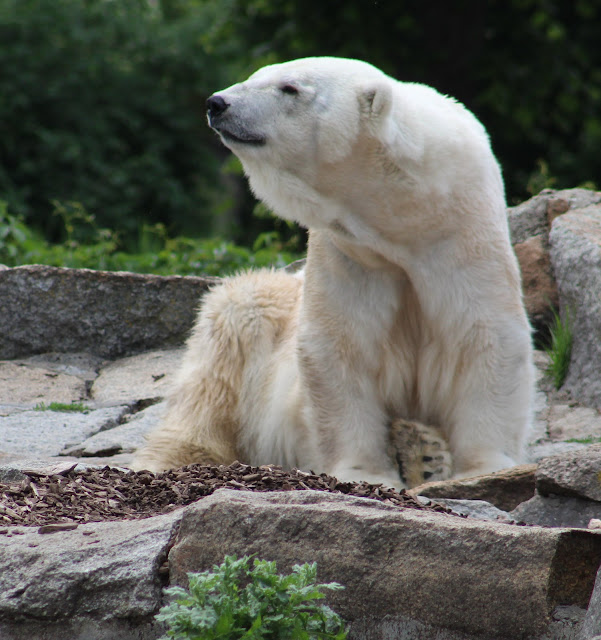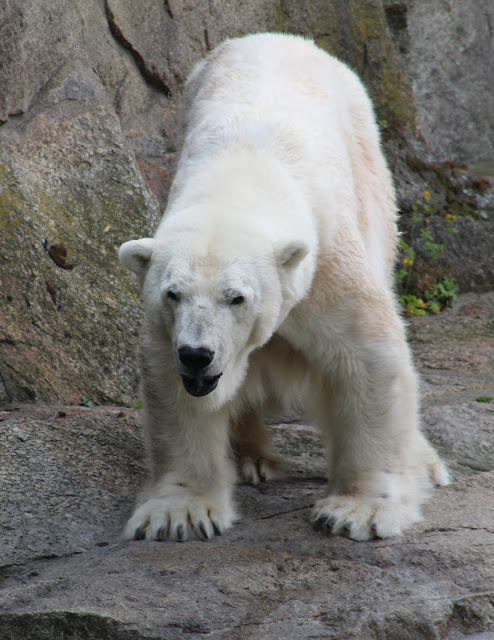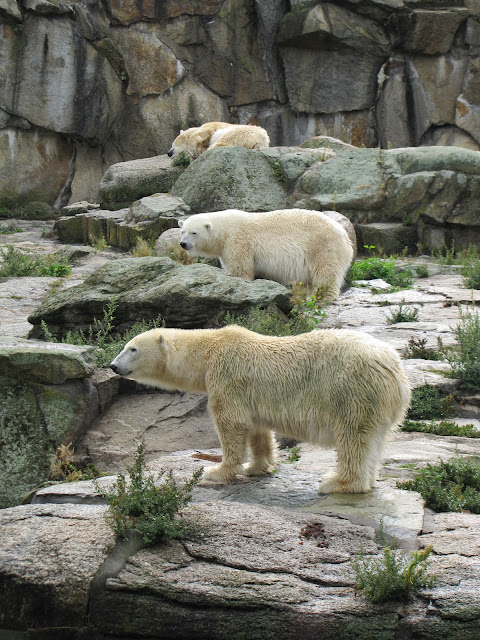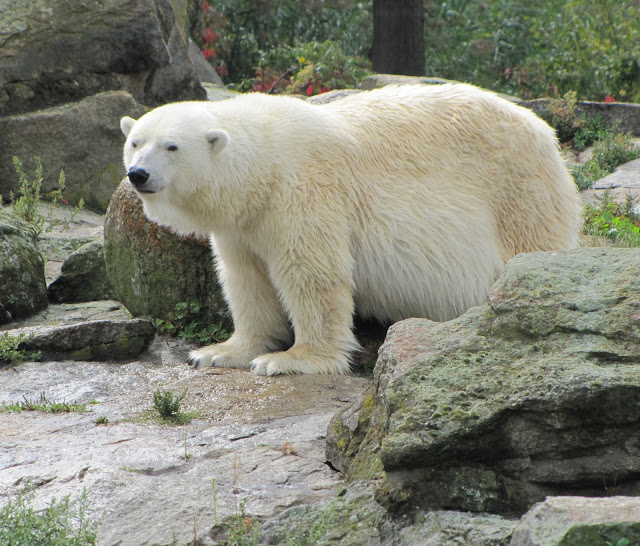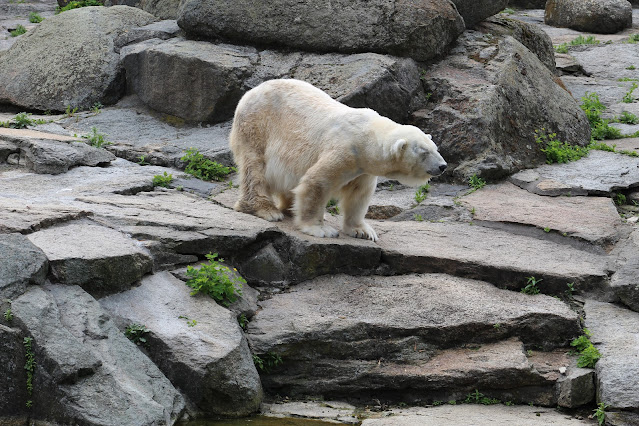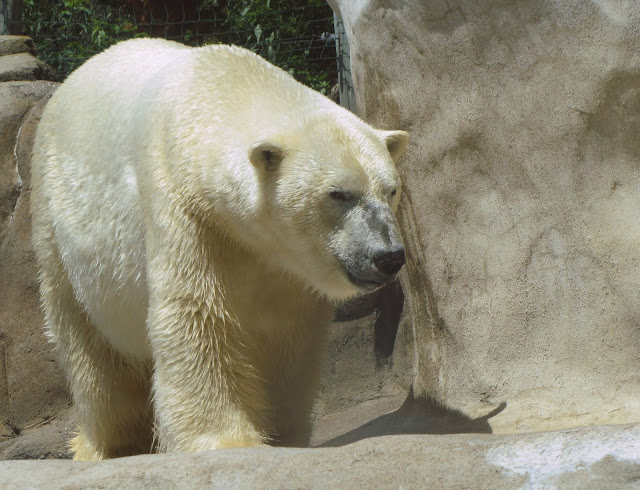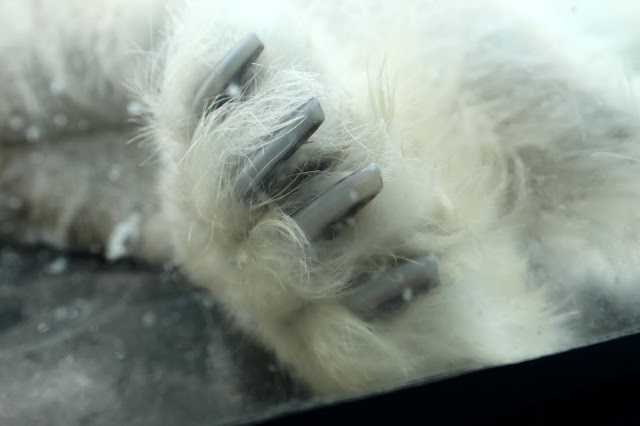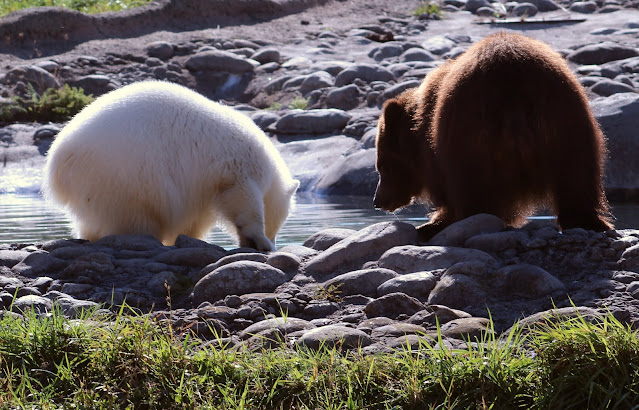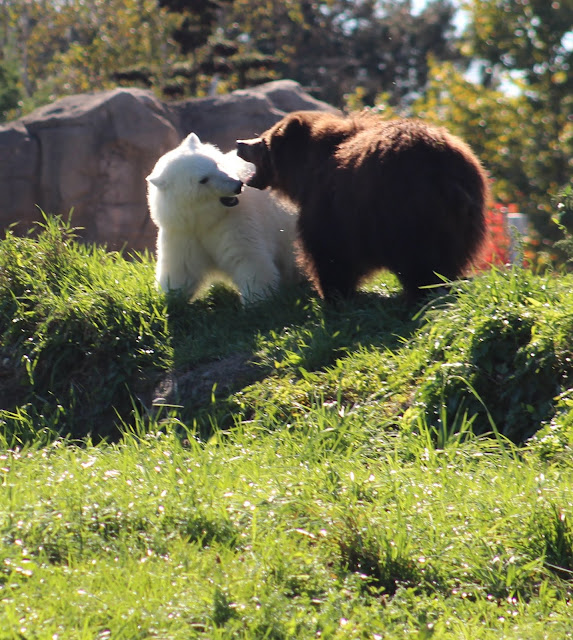 |
| Laerke and Jebbie |
The Arctic Ring of Life at the heart of the Detroit Zoo is home to a most unusual polar bear family these days.
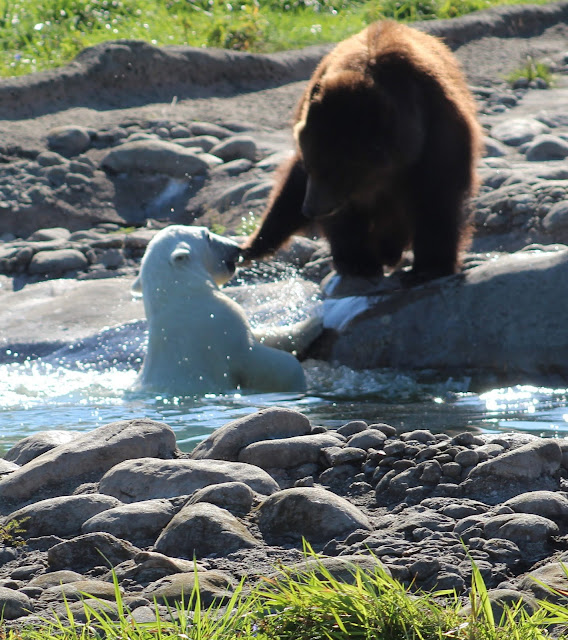 |
| Laerke in the pool, Jebbie on shore. |
It is an amazing sight you will not see anywhere else, a polar bear cub happily cavorting with a young grizzly. When the Detroit Zoo announced it had found a suitable companion for the handraised polar bear cub Laerke (pronounced Lyraca), the world took notice. This unusual pair has won hearts everywhere.
 |
Mother Suka and cub Astra in early August, in the Tundra section.
|
Throughout the spring and summer, Mother Suka and daughter Astra enjoyed the rolling hills and wildflowers of the Tundra area, while Papa Nuka occupied the Pack Ice area, often watching Suka and Astra from across the moat. |
| Laerke |
During this time, the mystery cub Laerke was not seen by the public. The small cub had been nearly lifeless two days after her birth last November, when she was whisked away to the zoo hospital for special care. The zoo hoped to locate another bear her age who was alone, maybe an orphan, so Laerke could develop bear social skills.
 |
| Astra and Suka |
 |
| Astra plays with her mom in the big pool. |
In August, keepers determined that Astra, weighing a hundred pounds more than her twin, was old enough to swim in the deep pool of the the Pack Ice section. Papa Nuka would spend his days in the Tundra meadow. Laerke remained inside, but by this time she had a furry companion.
 |
| Jebbie the Grizzly cub |
In June, grizzly bear cub Jebbie had been found wandering alone in an Alaskan village. The local people gave him this name, maybe named after the character in the children's tv show "Littlest Pet Shop." At just 76 pounds, he was too young to survive on his own, so he was taken to the Alaska Zoo for medical care and recovery from his ordeal. Keepers from the Detroit Zoo flew to Alaska to bring Jebbie to his new home at the Arctic Ring of Life, one of the best polar bear habitats in the world, where Laerke was waiting.
 |
| Jebbie |
 |
Jebbie, a Grizzly bear, is an omnivore.
|
After a suitable quarantine period for Jebbie, the two cubs were gradually and carefully introduced. Laerke's caretaker observed that Jebbie must have had siblings, for he knew how to play like a bear cub right away, but Laerke did not, and Jebbie had to teach her. The two shared toys, swam in the indoor pool, and created a bond.
 |
| Side by side. Jebbie is almost 60 pounds heavier. |
 |
Laerke and Jebbie
|
In late September, at long last, 10 month old Laerke was introduced to the public along with her companion Jebbie, in the Tundra area, which has a small freshwater pool.
 |
| Suka and Astra in the saltwater pool in the Pack Ice section. |
 |
Astra destroys a ball in the pack ice section.
|
These days Mama Suka and Laerke's twin sister dive and chase each other through the vast saltwater pool, while visitors gaze in wonder from the underwater viewing tunnel. |
Gentle Papa Nuka in the Tundra meadow,
doesn't mind the peacocks nearby.
The two cubs cannot come out until Papa Nuka comes in.
|
In the late afternoon, Papa Nuka wanders around the Tundra, often napping in the sun. Sometimes his mate Suka stands across the way and they send secret messages. When the keepers call Nuka to come inside in the morning, then the seemingly mismatched playmates can come out, a polar bear cub and a grizzly. And that is when things get really exciting. These two can play all day. They chase, wrestle, tumble around, run after peacocks, just have the most amazing fun together. They wear each other out.
 |
| Astra watches with envy at all the fun being had at the party next door. |
 |
| Jebbie is interested in Astra, would like her to come play too. |
 |
| Astra, way over there, is dirty after playing by herself in the mulch pile. |
Sometimes Mother Suka and Laerka's twin sister Astra watch the two cubs play from across the moat dividing the two areas, and Astra looks a little jealous, for there is this fun party going on in the Tundra area, and she's not invited.
 |
| Suka and Astra watch the action of the neighbors.. |
As for Suka, she likely does not recognize that Laerke is her missing cub.
 |
| Twin sisters and strangers. Astra far, Laerke close. |
 |
Jebbie and Laerke are being watched by Astra.
|
There are no plans to introduce Laerke and Jebbie to the Pack Ice area, for Grizzly bears are not marine animals, and Laerke needs supervision.
Laerke's latest weight is 160 pounds, and Jebbie is gaining faster, now at 208 pounds. Still, they seem well matched. I noticed that Laerke is usually the leader, and Jebbie follows. They love to wrestle, and sometimes Jebbie chases Laerke. She just jumps into the water then, and Jebbie circles the edge of the pool, for he doesn't want to get his head wet. He will go into the pool, but usually doesn't stay long.
 |
They are very well matched,
even though Jebbie now has the weight advantage. |
 |
| Happy together. |
Jebbie loves to play with his friend, but he is very good at entertaining himself too, rolling on his back and playing with his toes is a favorite game.
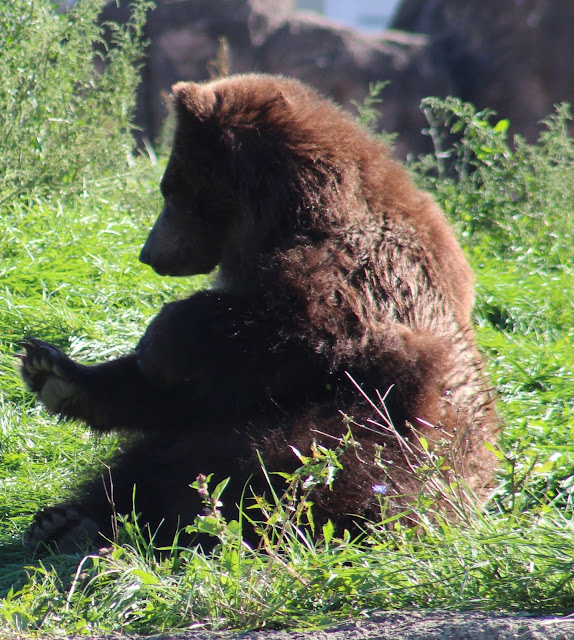 |
Jebbie is fascinated by his paw. His claws are much longer.
|
For Laerke, who sees her primary keeper as a parent, it has been hard to grow up. Physical contact without barriers ended at seven months for safety reasons, but she still relies on him, crying sometimes if she can't see him, and brightening up when she spots Rick.
 |
| Laerke spots Rick, her "daddy" probably coming with a bucket of treats. |
Jebbie, who didn't bond with humans as an infant, is much more independent. He is happy to get the toys and the food, but would rather play with Laerke or just be off on his own.
Laerke is usually the bear in the lead, as they march around the meadow. Jebbie follows close behind.
 |
| Horseplay, bear style. Laerke was standing on the side of the pool, and Jebbie pushed her in! |
The two cubs are put in separate bedrooms when it is time to rest, because Jebbie would just keep going, keep wanting to play, and no one would get any sleep.
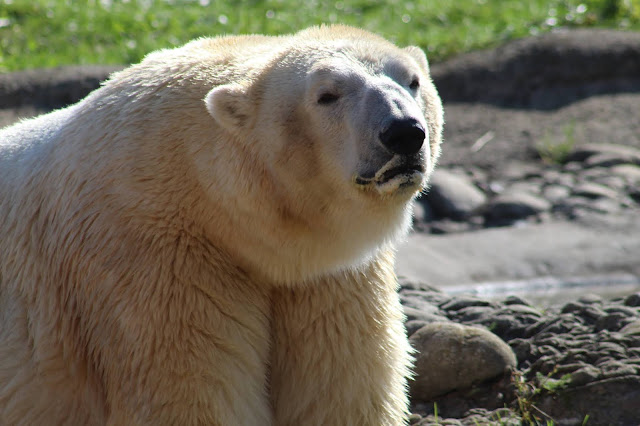 |
| Nuka foams up when he eats carrots, probably because he is missing part of his tongue. Laerke looks like her papa. |
Visitors to the Arctic Ring of Life may or may not see the dynamic duo, because Nuka is given the Tundra area at night, and he doesn't always want to return to the bedroom area in the morning. I visited for two days, and didn't see Jebbie and Laerke until the second day because Nuka wanted to nap in the sun all day on my first day.
 |
Play ball.
Here's Jebbie in the pool, but he keeps his ears dry.
|
These cubs may both be bears, with much in common, but grizzly bears are omnivores and land mammals, while polar bears are carnivores and marine mammals. Jebbie has very long claws, compared to a polar bear, and grizzly bears are more destructive to their environment (toys). Jebbie jabbed his claws into the weighing scale and broke it, so now they have to get a new scale.
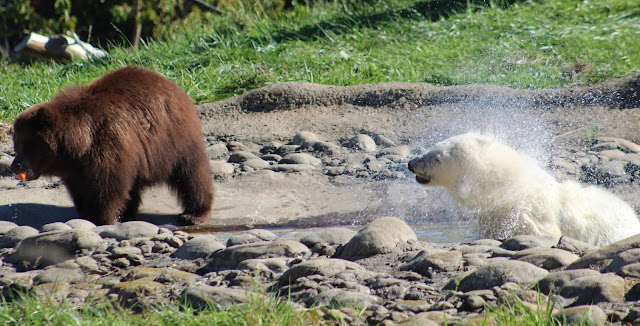 |
| Carrots for all. |
Jebbie and Laerke get the same kind of diet, but Jebbie gets a lot more fruits and vegetables and Laerke gets more fish and meat. They still get formula, not in a bottle anymore, but in a pan. Laerke's formula has some additional nutrients like salmon oil for marine mammals.
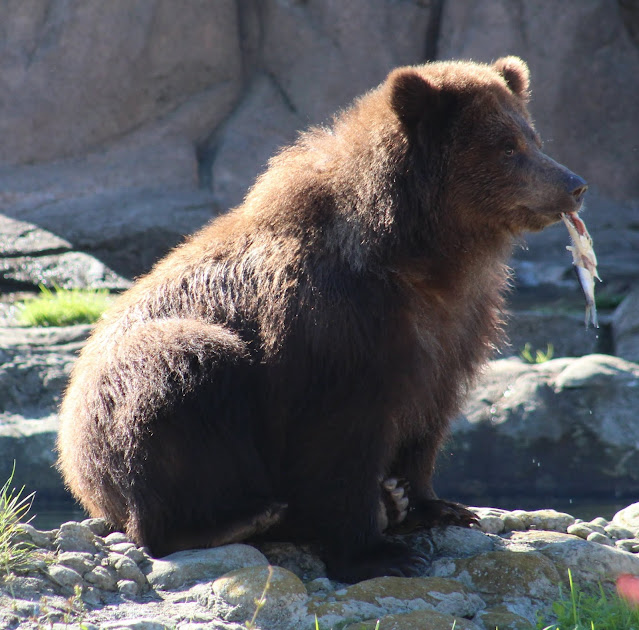 |
| Jebbie likes fish too, but not as much as Laerke, who is a carnivore. |
During my visit, all the bears got their favorite treat, carrots. Jebbie got some romaine lettuce. Jebbie and Laerke were given fish. This time of year, they get pumpkins too.
Grizzly bear males are always neutered when in zoos, for breeding is not allowed. All zoo grizzly situations are reserved for rescued bears.
Polar bears, on the other hand, are encouraged to breed. This past year, the only polar bear cubs born in a U.S. zoo were Suka and Nuka's twins. Last year, there was just one, Kulu in Columbus, now in the Como Zoo in St. Paul.
What is ahead for these two? No one knows how long they will be able to stay together, hopefully a long time. The Detroit Zoo is home to grizzly triplet brothers, but they are ten years old and probably wouldn't accept an intruder.
 |
| A bear hug from a friend. |
But for now, these two are happy to have a friend to play with, to learn from, and to love.
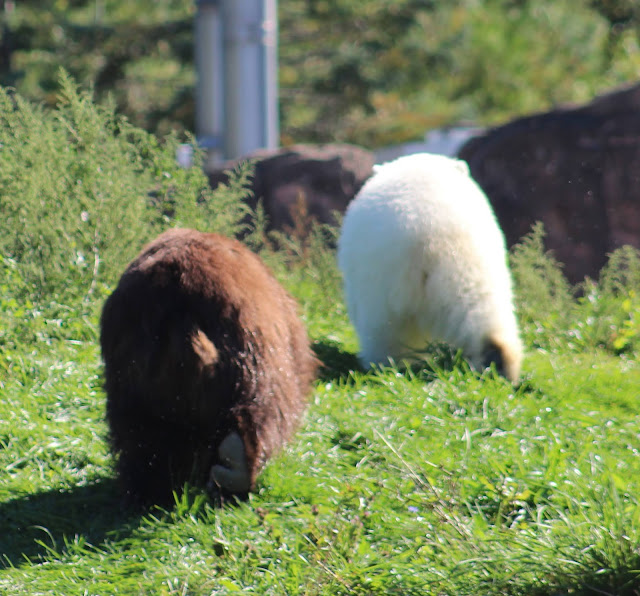 |
| As usual, Laerke leads the way. |

